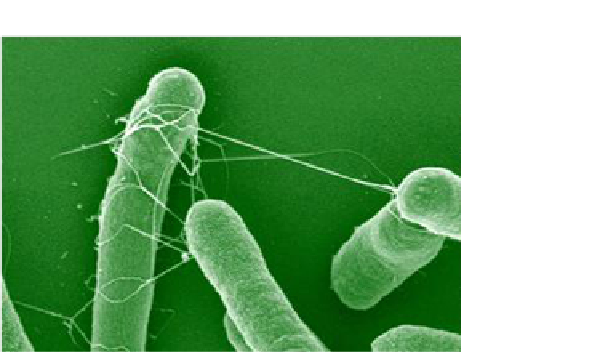Biology Reference
In-Depth Information
FIGURE 8.3
Scanning electron microscopy of EAEC wt strain 042. White arrow indicates AAF/
II fimbriae.
From
Sheikh et al. (2002)
.
The Afa/Dr adhesins bind to several receptors on epithelial cells, including
decay-accelerating factor (DAF) as well as extracellular matrix (ECM) proteins,
in particular type IV collagen (reviewed by
Servin, 2005
). Recent studies have
found that EAEC strain 042 expressing AAF/II binds the ECM fibronectin, lam-
inin, and type IV collagen proteins (
Farfan et al., 2008
).
Studies performed with EAEC strain 042 showed that AAF/II appears to be
important for biofilm (defined here as the association of bacteria into communi-
ties on abiotic surfaces) formation in EAEC strains producing these fimbriae
(
Sheikh et al., 2001
). In addition, it was established that the pAA plasmid from
EAEC strain 042 (pAA2) and EAEC strain C1010-00 (pAA4) was sufficient
to confer biofilm formation on commensal
E. coli
strain HS (
Harrington et al.,
2005
;
Boisen et al., 2008
). It was found that many EAEC strains not expressing
known AAFs developed biofilm under specific conditions suggesting that more
AAFs remain to be discovered (
Sheikh et al., 2001
).
Most (approximately 80%) EAEC strains secrete a 10-kDa protein called
dispersin, encoded by the
aap
gene. Dispersin secretion is dependent upon a
system called Aat (encoded by
aatPABCD
). Once outside the bacterium, dis-
persin remains non-covalently attached to the outer membrane. In dispersin
mutants, the AAF fimbriae are formed, but collapse and adhere tightly to the
surface of the bacterium (
Sheikh et al., 2002
). Consequently, dispersin serves to
insulate the surface of the bacterium so that the positively charged AAF is free
to extend away from the negatively charged cell surface.
A cluster of AggR-activated genes has been identified on the chromosome
of strain 042; these genes comprise a type VI secretion system and are encoded
within a chromosomal island called AAI which comprises a cluster a 16 pre-
dicted genes designated
aaiA
-
P
(
Dudley et al., 2006
). The contribution of the
aai
genes to EAEC pathogenesis is currently unknown, but these genes do not
appear to play a role in adherence to abiotic surfaces or intestinal epithelial cells,

Search WWH ::

Custom Search